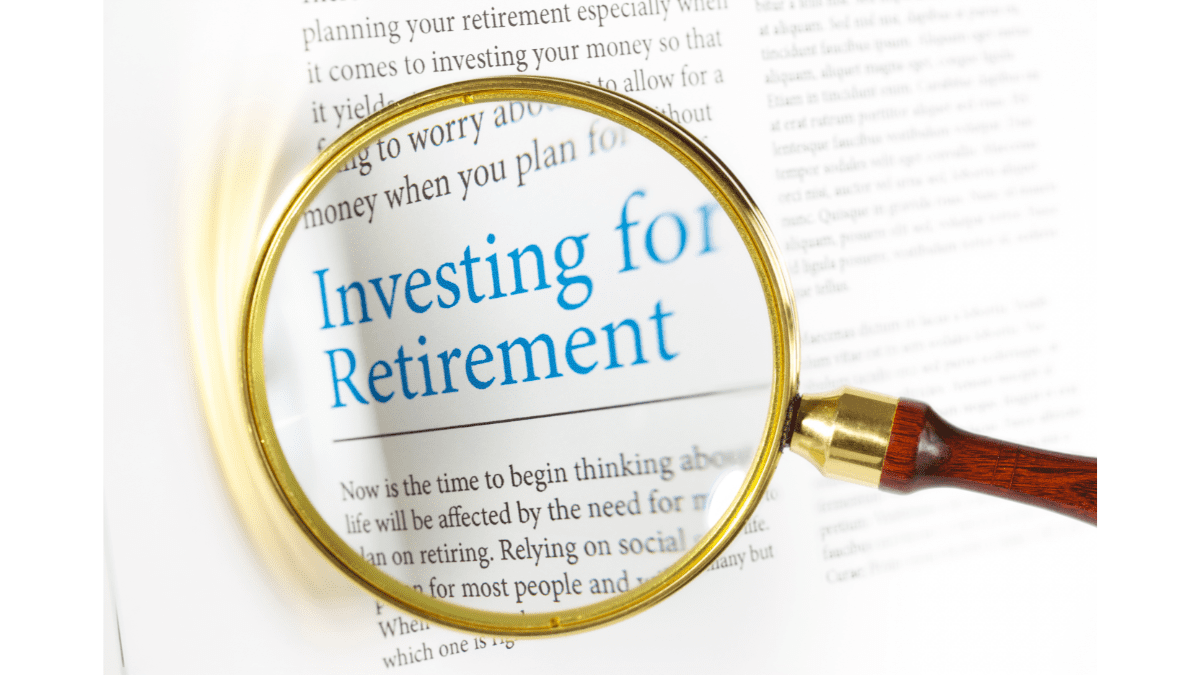Welcome to the gateway of financial security Investing for Retirement. In this simple guide, we’ll navigate the world of retirement planning together. Imagine it as your roadmap to a worry-free tomorrow. We’ll break down the why, the how, and the what of investing, making it easy for everyone, regardless of age or financial background. So, grab a cup of coffee, relax, and let’s dive into the key to a brighter and more secure future!
Table of Contents
The importance of retirement savings and planning
Retirement is like a destination on life’s journey, and planning for it is your roadmap to a comfortable and worry-free future. Here’s why saving and planning for retirement is crucial:
- Peaceful Golden Years: Imagine your retirement as a time to relax and enjoy life without financial stress. Saving ensures you have enough money to maintain a comfortable lifestyle when you stop working.
- Independence and Choices: Retirement savings give you the freedom to make choices. Whether it’s traveling, pursuing hobbies, or spending time with family, having savings provides the independence to do what you love.
- Avoiding Financial Worries: Planning ahead helps you avoid financial worries in retirement. Instead of stressing about money, you can focus on the things that bring you joy.
- Meeting Healthcare Needs: As we age, healthcare becomes more critical. Having savings allows you to afford medical expenses and ensures you receive the care you need.
- Maintaining Your Standard of Living: Retirement planning ensures you maintain your current standard of living. It’s about safeguarding the lifestyle you’ve worked hard to achieve.
Remember, by starting to save early and planning wisely, you’re not just securing your future; you’re investing in a life that continues to be fulfilling and enjoyable after your working years.
Why investing early for retirement is crucial
Investing early for retirement is like planting seeds for a bountiful harvest. Here’s why getting a head start is crucial:
- Time is Your Ally: When you start early, your money has more time to grow. It’s like a magical ingredient called “compound interest.” The longer your money stays invested, the more it multiplies and works for you.
- Building a Safety Net: Early investments create a robust safety net for your future. You’re essentially giving your money a longer runway to weather any financial storms and come out stronger.
- Less Stress, More Options: Early investors face less pressure. You don’t need to contribute large amounts because time is on your side. This means less stress and more flexibility in choosing your investment strategy.
- Catching Opportunities: Early birds catch the worms, and early investors catch the best opportunities. You can explore different investment options, take calculated risks, and potentially reap greater rewards.
- Peace of Mind: Picture this—knowing you’ve taken steps today for a secure tomorrow brings peace of mind. You’ll be more confident about your financial future, allowing you to focus on enjoying life.
In a nutshell, investing early is like planting a financial garden. The earlier you start, the more abundant the fruits of your labor will be when it’s time to enjoy the retirement harvest.
What is the Different investment options for retirement
Planning for retirement involves choosing the right tools to grow your money. Here are straightforward explanations of different investment options:
- 401(k): This is like a savings account for retirement offered by your employer. You contribute a portion of your salary, and often, your employer matches it. It’s a double boost for your retirement fund.
- IRA (Individual Retirement Account): An IRA is like a personal savings account for retirement. You contribute money, and it grows over time. There are different types, like Traditional IRAs and Roth IRAs, each with its own perks.
- Stocks: When you buy a stock, you’re buying a tiny piece of a company. Stocks have the potential for higher returns, but they also come with more risk. It’s like owning a piece of the action in the business world.
- Bonds: Bonds are like IOUs. When you buy a bond, you’re lending money to a company or government. In return, they pay you back with interest over time. Bonds are generally considered safer than stocks.
- Mutual Funds: Imagine a basket filled with different investments like stocks and bonds. That’s a mutual fund. It’s a way to diversify your investments without having to pick each stock or bond individually.
- Real Estate: Investing in real estate means buying property. It could be a house, apartment, or even commercial space. Real estate has the potential to grow in value over time and can provide rental income.
- Savings Accounts: These are like a safe haven for your money. While they may not offer high returns, they are low-risk and easily accessible. It’s a good place to keep some of your retirement savings for emergencies.
Choosing the right mix of these options depends on your goals and comfort with risk. Diversifying, or spreading your money across different types of investments, is a smart strategy to balance potential gains and protect against losses.
Retirement Savings: The Foundation for Financial Security
Importance of setting financial goals for retirement
Setting financial goals for retirement is like planning a road trip. Without a destination in mind, it’s challenging to map out the journey. Similarly, identifying your retirement goals helps define how much money you’ll need and by when. Whether it’s a comfortable beachside retreat or pursuing lifelong passions, knowing your financial destination is the first step towards a secure retirement. It’s about turning dreams into achievable milestones.
Calculation of retirement savings needed based on desired lifestyle and retirement age
Imagine retirement as a book, and your desired lifestyle and retirement age as its chapters. Calculating the savings needed is like outlining the story. Consider the lifestyle you envision travel, hobbies, family time—and decide when you want this next chapter to begin. Crunching the numbers helps determine how much money should be in your savings account to turn your retirement story into a bestseller. It’s about ensuring that each chapter is written with financial comfort and security.
Different retirement savings vehicles (401(k), IRA, etc.) and their benefits
Now, let’s explore the vehicles that will carry your retirement dreams forward. Think of a 401(k) or an IRA as your reliable travel companions on this financial journey. These retirement savings vehicles come with unique perks—tax advantages, employer matches, and investment growth potential. A 401(k) is like a partner offering workplace support, while an IRA provides individual flexibility. Understanding these options is crucial, as they serve as the engines propelling you towards a financially secure retirement destination.
Retirement Planning: Mapping Out Your Financial Future

Creating a retirement plan is akin to drawing a treasure map for your financial future. Step one involves listing your current assets and estimating your future income. Then, set clear goals for your retirement—like milestones on your map. Next, determine how much you need to save regularly to reach those goals. Your plan is your compass, guiding you towards a secure retirement by breaking down the journey into manageable steps. Each step ensures you stay on course, inching closer to the treasure of a worry-free retirement.
Think of determining your risk tolerance as selecting the right vehicle for your journey. Are you comfortable with a smooth ride or seeking a bit of adventure? Your risk tolerance guides your investment strategy. If you prefer a steady pace, conservative investments may be your choice. If you’re up for a bit of excitement, a more aggressive approach might suit you. It’s about aligning your investment choices with your comfort level, ensuring a ride that’s both enjoyable and secure.
Tips for adjusting your retirement plan as life circumstances change. Life is an ever-changing landscape, and your retirement plan should be adaptable. Picture your plan as a flexible map that can be updated with new routes. If unexpected detours occur job changes, family expansions, or market fluctuations—don’t worry. It’s normal. The key is to regularly revisit your map, adjusting it to accommodate life’s twists and turns. This ensures your financial journey remains smooth, even when the road takes unexpected bends.
Tips for Adjusting Your Retirement Plan:
- Regular Check-ins: Schedule periodic reviews to assess your plan’s alignment with your goals.
- Flexibility is Key: Be open to adjusting contributions and investment choices based on changes in income or priorities.
- Emergency Lane: Build an emergency fund within your plan to navigate unexpected financial bumps with ease.
Investment Options for Retirement: Building Wealth in a Secure Manner
Think of investment vehicles as the various tools in your financial toolbox, each serving a unique purpose.
For retirement, consider options like stocks, bonds, mutual funds, real estate, and more. These vehicles are like different pathways to your financial goals. Understanding the variety available empowers you to choose the ones that align with your risk tolerance and long-term objectives.
Let’s take a closer look at the stars of the investment show.
- Stocks are like shares of ownership in companies, offering growth potential.
- Bonds, on the other hand, are like loans to governments or corporations, providing stability.
- Mutual funds pool money from various investors, offering diversification.
- Real estate involves investing in properties, adding a tangible touch to your portfolio.
Each option has its unique characteristics, so understanding their roles in your investment strategy is key to a well-rounded portfolio.
Just like any decision in life, each investment option comes with its own set of pros and cons.
- Stocks may offer high returns but involve more risk.
- Bonds provide stability but might yield lower returns.
- Mutual funds offer diversity but come with management fees.
- Real estate can be lucrative but requires hands-on management.
Evaluating the potential returns and drawbacks of each option helps you make informed decisions tailored to your financial goals and risk tolerance. It’s all about finding the right balance for your unique investment journey.
The Power of Investing Early for Retirement: Time is on Your Side
What is Compound Interest and its Impact on Long-Term Investments:
Understanding compound interest is like witnessing the growth of a snowball rolling down a hill.
Imagine your initial investment as the snowball’s starting point. Compound interest is the snow that accumulates as the ball rolls, making it bigger with each turn.
In financial terms, compound interest means earning not only interest on your initial investment but also on the interest that accrues over time. The earlier you begin, the more time your investment has to gather this snowball effect, resulting in substantial growth over the long term.
Compound interest is the engine that propels your money forward, emphasizing the importance of starting your investment journey as early as possible.
Case Studies Showcasing the Benefits of Investing Early for Retirement:
- Tom’s Early Start: Tom started investing for retirement at 25. He consistently put money into his retirement fund each month. By the time he reached 60, his retirement nest egg had grown significantly, providing him a comfortable retirement.
- Lisa’s Delayed Start: Lisa, on the other hand, began investing at 35. While she invested the same amount each month as Tom, her retirement fund didn’t grow as much due to the shorter time. Lisa realized the power of time a bit late, and though she still had a decent nest egg, it wasn’t as robust as Tom’s.
- Meet Alex: who started investing a portion of their income in a retirement account in their early 20s. By consistently contributing a modest amount each month, Alex let time work. Fast forward to their 60s, and Alex’s retirement fund had grown significantly, providing financial security and the freedom to enjoy their golden years stress-free.
- Jamie: who began investing in their 30s. Despite starting a bit later, Jamie prioritized regular contributions to their retirement savings. By maintaining discipline and taking advantage of employer matching programs, Jamie accumulated substantial wealth over the years. In their 60s, Jamie embraced retirement comfortably, thanks to the diligence of earlier years.
- Taylor: who decided to start investing in their 40s. Recognizing the importance of catching up, Taylor made more substantial contributions to their retirement fund. With strategic investment choices and a commitment to consistency, Taylor’s retirement savings grew significantly, showcasing that even a later start can yield fruitful results with dedication.
These case studies emphasize a common theme the earlier you start investing for retirement, the more time your money has to grow, leading to a financially secure and fulfilling retirement.
Tips for Starting to Invest for Retirement at Any Age and Maximizing Potential Returns:
- Assess Your Finances: Take stock of your current financial situation, including income, expenses, and existing savings.
- Set Achievable Goals: Define realistic retirement goals based on your age, lifestyle, and expected needs.
- Seek Professional Guidance: Consider consulting with a financial advisor to create a personalized investment strategy.
- Educate Yourself: Take the time to understand different investment options and their associated risks and rewards.
- Start Small, Stay Consistent: Begin with manageable contributions and consistently increase them over time.
- Leverage Employer Benefits: If available, contribute to employer-sponsored retirement plans, especially if they offer matching contributions.
- Diversify Your Portfolio: Spread your investments across different asset classes to minimize risk and maximize potential returns.
- Regularly Review and Adjust: Periodically reassess your investment portfolio to ensure it aligns with your changing financial goals.
- Stay Disciplined: Stick to your investment plan even during market fluctuations, avoiding impulsive decisions.
- Take Advantage of Tax Benefits: Explore tax-advantaged retirement accounts to maximize your savings and minimize tax liabilities.
- Reinvest Dividends: Consider reinvesting any dividends earned to further capitalize on the power of compound interest.
- Stay Informed: Stay updated on market trends and financial news to make informed investment decisions.
Remember, the key to successful retirement investing is consistency, informed decision-making, and a long-term perspective.
Retirement Funds: A Diversified Approach to a Secure Financial Future
Retirement funds are like trustworthy financial partners working to build a secure future for you. These funds are essentially diversified investment packages that combine various assets such as stocks, bonds, and securities.
The primary goal of retirement funds is to help individuals grow their savings over time. What makes them beneficial is their ability to spread the risk across different investments, reducing the impact of market fluctuations.
Additionally, retirement funds often come with professional management, ensuring that your money is handled by experts who make informed decisions on your behalf. By pooling resources from many investors, these funds offer a convenient and effective way to prepare for a financially stable retirement.
Difference Between Target-Date Funds and Balanced Funds:
| Feature | Target-Date Funds | Balanced Funds |
|---|---|---|
| Investment Mix | Adjusts over time based on retirement date. | Maintains a fixed mix of stocks and bonds. |
| Risk Level | Becomes more conservative as the target date approaches. | Maintains a steady risk level throughout. |
| Management | Professionally managed to align with the fund’s target date. | Professionally managed to maintain a balanced portfolio. |
| Diversification | Automatically diversified across various asset classes. | Manually balanced between stocks and bonds. |
| Suitability | Suited for investors planning for a specific retirement date. | Suited for those seeking a consistent risk-reward balance. |
| Hands-Off Approach | Requires less active management as it adjusts automatically. | Requires periodic rebalancing by the investor or fund manager. |
| Flexibility | Offers a set-and-forget approach for long-term investors. | Allows investors to have more control over their asset allocation. |
| Example Scenario | Ideal for someone planning to retire in 2050. | Ideal for an investor comfortable with a stable mix of assets. |
Remember, both types of funds serve specific purposes, and the choice depends on an individual’s financial goals, risk tolerance, and preferred level of involvement in managing their investments.
Tips for Selecting the Right Retirement Fund Based on Individual Goals and Risk Tolerance:
- Assess Your Goals: Define your retirement goals, considering factors like lifestyle, desired age of retirement, and financial needs.
- Determine Risk Tolerance: Understand how comfortable you are with investment risk. Assess whether you prefer a more conservative or aggressive approach.
- Understand Fund Types: Learn about different retirement fund types, such as target-date funds and balanced funds, and how they align with your objectives.
- Consider Investment Horizon: Evaluate the time until your retirement. Shorter timelines may favor target-date funds, while balanced funds offer a stable approach for the long term.
- Review Historical Performance: Examine the past performance of potential funds to gauge how well they align with your expectations and risk tolerance.
- Diversification Strategy: Consider the fund’s approach to diversification. Ensure it aligns with your preference for spreading risk across various assets.
- Management Expertise: Look into the fund manager’s expertise and track record. A well-managed fund can contribute to long-term success.
- Fees and Expenses: Evaluate the fees associated with the fund. Lower fees can positively impact your overall returns over time.
- Read the Fund’s Prospectus: Review the fund’s prospectus for detailed information on its objectives, strategy, and any potential risks.
- Seek Professional Advice: Consider consulting with a financial advisor for personalized guidance based on your specific financial situation and goals.
- Regularly Review and Adjust: Periodically reassess your chosen fund to ensure it continues to align with your evolving goals and risk tolerance.
Encouragement for individuals to start investing early for retirement
To those contemplating the right time to embark on the investment journey, consider this your call to action. The earlier you start, the more time your investments have to grow and flourish. Time is your ally in the realm of finances, and starting early is a gift to your future self. Embrace the power of compound interest, let your money work for you, and watch your retirement dreams take shape.
As we conclude, remember that securing a financially stable future is not just a possibility but a reality within your grasp. Wise investment choices, guided by a well-thought-out plan, can turn aspirations into achievements. It’s about aligning your investments with your goals, adapting as life unfolds, and making informed decisions along the way. Your financial journey is uniquely yours, and each step you take today shapes the narrative of your tomorrows.

In the grand tapestry of life, your retirement is a chapter awaiting vibrant colors. Through diligent savings, early investments, and strategic choices, you’re not just preparing for retirement; you’re crafting a masterpiece of financial security and freedom. May your journey be prosperous, and may your retirement be a chapter filled with joy, comfort, and the rewards of prudent financial stewardship.
Also Read: ETFs or Real Mutual Funds – Which investment vehicle is right for you?


4 thoughts on “Investing for retirement savings: A Comprehensive Guide”